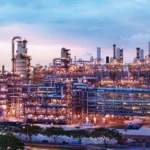Oil and Gas Industry Embraces Advanced Technologies to Boost Efficiency and Sustainability

Oil and Gas Industry Embraces Advanced Technologies to Boost Efficiency and Sustainability in 2025
Houston, USA
The global oil and gas industry is undergoing a technological revolution in 2025, driven by the need to enhance operational efficiency, reduce costs, and align with energy transition goals. Companies are leveraging artificial intelligence (AI), digital twins, the Industrial Internet of Things (IIoT), and other innovations to optimize exploration, production, and refining processes. Amid a projected oil surplus and geopolitical uncertainties, these advancements are critical for maintaining competitiveness in a rapidly evolving market.
AI-Powered Exploration and Production
Artificial intelligence is transforming upstream operations, enabling companies to improve exploration accuracy and production efficiency. AI-driven seismic imaging, used by firms like ExxonMobil and BP, has increased reservoir recovery rates by 8–10% in fields like the Permian Basin and North Sea. Machine learning algorithms analyze vast datasets to predict drilling outcomes, reducing exploration costs by 15% at select sites in 2024. For example, Chevron’s deployment of AI in the Jack/St. Malo field in the Gulf of Mexico has optimized well placement, boosting output by 7% while cutting operational expenses.
Digital Twins Enhance Operational Performance
Digital twins—virtual replicas of physical assets—are revolutionizing asset management in the oil and gas sector. Companies like Shell are using digital twins to monitor real-time performance at facilities like the Prelude FLNG platform, reducing downtime by 12% and maintenance costs by 10% in 2024. These systems integrate data from sensors and predictive analytics to simulate operations, enabling proactive maintenance and process optimization. In 2025, digital twin adoption is expected to grow by 20%, with Saudi Aramco reporting a 15% efficiency gain in its Khurais field through their use.
IIoT and Automation Streamline Operations
The Industrial Internet of Things (IIoT) is enabling real-time monitoring and automation across the value chain. IoT-enabled sensors at TotalEnergies’ Qatari LNG facilities have improved production uptime by 8%, while automated drilling systems in the U.S. shale sector have reduced rig times by 20%. In 2025, IIoT is projected to save the industry $10 billion annually by optimizing supply chains and reducing equipment failures. Companies like Equinor are also using IoT to monitor methane emissions, cutting leaks by 6% in 2024, aligning with stricter environmental regulations.
Carbon Capture and Sustainability Technologies
Technological advancements are critical to the industry’s energy transition efforts, particularly in carbon capture, utilization, and storage (CCUS). ExxonMobil’s LaBarge facility in Wyoming captures 8 million metric tons of CO2 annually, with plans to scale up to 11 million tons by 2028. AI-driven CCUS optimization is reducing capture costs by 10%, though only 43% of industry executives surveyed by Deloitte in 2025 prioritize CCUS due to high initial investments. Additionally, renewable energy integration, such as Cheniere Energy’s 50 MW solar-powered LNG plant in Corpus Christi, is lowering emissions by 5% at select facilities.
Blockchain for Supply Chain Transparency
Blockchain technology is gaining traction for enhancing supply chain transparency and security. In LNG trading, companies like QatarEnergy are using blockchain to streamline contracts and reduce transaction costs by 6% in 2024. This technology ensures traceability of carbon credits and verifies supply chain data, supporting compliance with environmental regulations. By 2025, blockchain adoption is expected to grow by 15%, particularly in downstream operations, improving trust in global trade networks.
Petrochemical and Refining Innovations
The petrochemical sector, projected to drive 18–20% of global oil demand by 2040, is benefiting from technological advancements. AI-driven process optimization at Saudi Aramco’s Jazan refinery has reduced production costs by 7%, while digital twins at China Petroleum & Chemical Corporation’s ethylene plants have improved yields by 5%. These technologies are critical as companies face competition from low-cost producers and global supply chain disruptions, ensuring efficiency in high-demand markets like Asia.
Cybersecurity and Workforce Impacts
As digital technologies proliferate, cybersecurity is a growing concern. The industry reported 300 cyberattacks on oil and gas infrastructure in 2024, prompting companies like BP to invest $500 million in AI-powered threat detection systems in 2025. Workforce dynamics are also shifting, with automation leading to 10,000 job cuts globally in 2024–2025. However, retraining programs are transitioning 5,000 workers to roles in digital operations and renewables, supported by initiatives like the U.S. Department of Energy’s $200 million workforce development fund.
Market Pressures and Outlook
The adoption of these technologies comes amid a projected oil surplus of 1.7 million b/d by early 2026, which could push Brent crude prices down to $50 per barrel from $68 in August 2025. Geopolitical risks, including tensions in the Strait of Hormuz, handling 21% of global petroleum liquids, add uncertainty. As companies like Shell, ExxonMobil, and TotalEnergies integrate AI, digital twins, and CCUS, they are better positioned to navigate market volatility and sustainability pressures. The industry’s ability to leverage these technologies will shape its competitiveness and role in the global energy transition through 2030.







